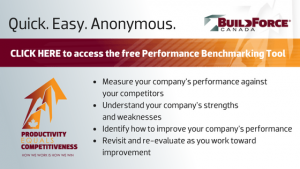What is Benchmarking and Why is it Important?
The term “benchmarking” was originally coined by land surveyors, who used the term to identify a fixed point from which all other measurements are made. In the late 1970’s it took on a broader meaning when applied to industry. Businesses such as AT&T, Motorola, and Xerox embraced the process as standard operating procedure in the mid- to late 1980’s. Governmental and non-profit organizations have been benchmarking since the early 1990’s.
Benchmarking has been defined as the “process of seeking out and implementing best practices at best cost”. It is a logical and systematic method of improving performance by comparing one’s business processes to industry metrics and best practices from other companies. “Best practice benchmarking” or “process benchmarking” assists organizations identify areas to make improvements or adapt best practices. This has become a popular approach to managing quality in the construction industry.
Measuring construction processes against industry best practices has been a staple in the UK for many years. Increased interest has been encouraged by the publication of key performance indicators allowing companies to measure their performance and to set targets based on nation-wide performance data. This is a continuous process by which organizations gain insight, drive improvement and increase performance.
Steps to Successful Benchmarking
Plan: Establish what needs to be improved and ensure it is important to you and your customers.
Analyze: Gather data, determine the current performance gap and identify reasons for the differences. (Against a competitor, the industry or internally)
Act: Develop and implement improvement plans & performance targets.
Review: Monitor performance against the performance targets.
Repeat: Repeat the process. Habitual benchmarking becomes a well-worn yardstick to measure and drive performance improvement.
BuildForce’s Benchmarking Tool
The recently released Performance Benchmarking Self-Assessment Tool is designed to assist construction and maintenance employers measure their processes against a specific set of recognized best practices. Participants compare organizational efforts to identify successes and areas for improvement. The tool is a component of a national project to improve productivity and performance through technology. The project builds on work carried out by the Universities of New Brunswick, Waterloo, Manitoba and British Columbia. Funding is provided by the National Research Council of Canada under the Industrial Research Assistance Program (NRC-IRAP).
What Does the Tool Measure?
- Time Management Practices
- Cost Management Practices
- Quality Management Practices
- Scope Management Practices
- Health and Safety Management
- HR Management Practices
- Materials Management Practices
- Information and Communications Planning
- Environmental and Waste Management Practices
The tool draws from over 100 questions on internationally recognized best practices and takes 30 -45 minutes to complete. All information collected is kept confidential and data provided by companies will remain anonymous.
Benefits of Using the Tool:
- Improve performance and productivity
- Improve profits
- Achieve continuous improvement
- Win new work by demonstrating benchmark performance on a wide range of criteria
- Receive repeat business by providing evidence of satisfactory performance
Benchmarking allows employers to evaluate performance and ensure business is operating at an optimum level. BuildForce’s new online tool gives employers an opportunity to quickly, easily and anonymously learn how their company stacks up against the competition. Once a company’s answers are submitted, participants receive a free analysis showing how they compare to industry competition in key areas. Owners, principals and the management team should complete the questions together to best capture the company’s practice. Collaborative discussion can produce fresh insights and alternative perspectives.
We cannot improve what we do not measure.
Need more info? Interested in attending a webinar to learn more?
